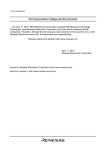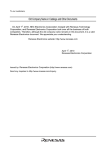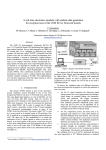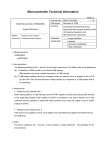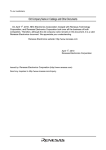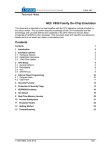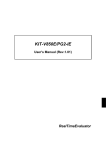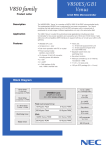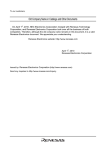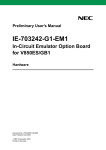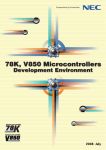Download (V850E/IA3, V850E/IA4, V850ES/IK1, V850ES/IE2) AN
Transcript
Manual for Using Sample Program Functions Clock Generator (V850E/IA3, V850E/IA4, V850ES/IK1, V850ES/IE2) This manual explains the sample program functions of the clock generator for the V850E/IA4 microcontroller. The explanations are based on usage with the V850E/IA4 microcontroller. Refer to this manual when using the V850E/IA3, V850ES/IK1, and V850ES/IE2 microcontrollers. Caution This sample program is provided for reference purposes only and operations are therefore not subject to guarantee by NEC Electronics Corporation. When using this sample program, customers are kindly advised to sufficiently evaluate this product based on their system before usage. Document No. U18242EJ1V0AN00 (1st edition) Date Published November 2006 N CP(K) 1 2006 NOTES FOR CMOS DEVICES 1 VOLTAGE APPLICATION WAVEFORM AT INPUT PIN Waveform distortion due to input noise or a reflected wave may cause malfunction. If the input of the CMOS device stays in the area between VIL (MAX) and VIH (MIN) due to noise, etc., the device may malfunction. Take care to prevent chattering noise from entering the device when the input level is fixed, and also in the transition period when the input level passes through the area between VIL (MAX) and VIH (MIN). 2 HANDLING OF UNUSED INPUT PINS Unconnected CMOS device inputs can be cause of malfunction. If an input pin is unconnected, it is possible that an internal input level may be generated due to noise, etc., causing malfunction. CMOS devices behave differently than Bipolar or NMOS devices. Input levels of CMOS devices must be fixed high or low by using pull-up or pull-down circuitry. Each unused pin should be connected to VDD or GND via a resistor if there is a possibility that it will be an output pin. All handling related to unused pins must be judged separately for each device and according to related specifications governing the device. 3 PRECAUTION AGAINST ESD A strong electric field, when exposed to a MOS device, can cause destruction of the gate oxide and ultimately degrade the device operation. Steps must be taken to stop generation of static electricity as much as possible, and quickly dissipate it when it has occurred. Environmental control must be adequate. When it is dry, a humidifier should be used. It is recommended to avoid using insulators that easily build up static electricity. Semiconductor devices must be stored and transported in an anti-static container, static shielding bag or conductive material. All test and measurement tools including work benches and floors should be grounded. The operator should be grounded using a wrist strap. Semiconductor devices must not be touched with bare hands. Similar precautions need to be taken for PW boards with mounted semiconductor devices. 4 STATUS BEFORE INITIALIZATION Power-on does not necessarily define the initial status of a MOS device. Immediately after the power source is turned ON, devices with reset functions have not yet been initialized. Hence, power-on does not guarantee output pin levels, I/O settings or contents of registers. A device is not initialized until the reset signal is received. A reset operation must be executed immediately after power-on for devices with reset functions. 5 POWER ON/OFF SEQUENCE In the case of a device that uses different power supplies for the internal operation and external interface, as a rule, switch on the external power supply after switching on the internal power supply. When switching the power supply off, as a rule, switch off the external power supply and then the internal power supply. Use of the reverse power on/off sequences may result in the application of an overvoltage to the internal elements of the device, causing malfunction and degradation of internal elements due to the passage of an abnormal current. The correct power on/off sequence must be judged separately for each device and according to related specifications governing the device. 6 INPUT OF SIGNAL DURING POWER OFF STATE Do not input signals or an I/O pull-up power supply while the device is not powered. The current injection that results from input of such a signal or I/O pull-up power supply may cause malfunction and the abnormal current that passes in the device at this time may cause degradation of internal elements. Input of signals during the power off state must be judged separately for each device and according to related specifications governing the device. 2 Application Note U18242EJ1V0AN These commodities, technology or software, must be exported in accordance with the export administration regulations of the exporting country. Diversion contrary to the law of that country is prohibited. • The information in this document is current as of July, 2006. The information is subject to change without notice. For actual design-in, refer to the latest publications of NEC Electronics data sheets or data books, etc., for the most up-to-date specifications of NEC Electronics products. Not all products and/or types are available in every country. Please check with an NEC Electronics sales representative for availability and additional information. • No part of this document may be copied or reproduced in any form or by any means without the prior written consent of NEC Electronics. NEC Electronics assumes no responsibility for any errors that may appear in this document. • NEC Electronics does not assume any liability for infringement of patents, copyrights or other intellectual property rights of third parties by or arising from the use of NEC Electronics products listed in this document or any other liability arising from the use of such products. No license, express, implied or otherwise, is granted under any patents, copyrights or other intellectual property rights of NEC Electronics or others. • Descriptions of circuits, software and other related information in this document are provided for illustrative purposes in semiconductor product operation and application examples. The incorporation of these circuits, software and information in the design of a customer's equipment shall be done under the full responsibility of the customer. NEC Electronics assumes no responsibility for any losses incurred by customers or third parties arising from the use of these circuits, software and information. • While NEC Electronics endeavors to enhance the quality, reliability and safety of NEC Electronics products, customers agree and acknowledge that the possibility of defects thereof cannot be eliminated entirely. To minimize risks of damage to property or injury (including death) to persons arising from defects in NEC Electronics products, customers must incorporate sufficient safety measures in their design, such as redundancy, fire-containment and anti-failure features. • NEC Electronics products are classified into the following three quality grades: "Standard", "Special" and "Specific". The "Specific" quality grade applies only to NEC Electronics products developed based on a customerdesignated "quality assurance program" for a specific application. The recommended applications of an NEC Electronics product depend on its quality grade, as indicated below. Customers must check the quality grade of each NEC Electronics product before using it in a particular application. "Standard": Computers, office equipment, communications equipment, test and measurement equipment, audio and visual equipment, home electronic appliances, machine tools, personal electronic equipment and industrial robots. "Special": Transportation equipment (automobiles, trains, ships, etc.), traffic control systems, anti-disaster systems, anti-crime systems, safety equipment and medical equipment (not specifically designed for life support). "Specific": Aircraft, aerospace equipment, submersible repeaters, nuclear reactor control systems, life support systems and medical equipment for life support, etc. The quality grade of NEC Electronics products is "Standard" unless otherwise expressly specified in NEC Electronics data sheets or data books, etc. If customers wish to use NEC Electronics products in applications not intended by NEC Electronics, they must contact an NEC Electronics sales representative in advance to determine NEC Electronics' willingness to support a given application. (Note) (1) "NEC Electronics" as used in this statement means NEC Electronics Corporation and also includes its majority-owned subsidiaries. (2) "NEC Electronics products" means any product developed or manufactured by or for NEC Electronics (as defined above). M8E 02. 11-1 3 Application Note U18242EJ1V0AN INTRODUCTION Cautions 1. Download the program used in this manual from the NEC Electronics Website (http://www.necel.com/). 2. When using this sample program, reference the following startup file and link directive file and adjust them if as necessary. • Startup file: IA4_start.s • Link directive file: IA4_link.dir Conventions The function lists are structured as follows. Hardware name [Function] Function description [Function name] Name of sample function [Argument] Type and overview of argument [Processing content] Processing content of sample function [Starting method] Conditions for calling a function [SFR(s) used] Register name and setting content [call function(s)] Name and function of call function(s) [Variable(s)] Type, name, and overview of variable(s) used in sample function [Interrupt(s)] Name of function [Interrupt source(s)] Name [File name] Name of corresponding sample program file [Caution(s)] Caution(s) upon function usage Product Differences The differences between the V850E/IA4 and the V850E/IA3, V850ES/IK1, and V850ES/IE2 related to the clock generator are shown below. Item V850E/IA4 V850E/IA3 V850ES/IK1 V850ES/IE2 Resonator 4 to 8 MHz resonator connectable (external clock input prohibited) 4 to 8 MHz resonator connectable (external clock input prohibited) 2.5 to 4 MHz resonator connectable (external clock input prohibited) 2.5 MHz resonator connectable (external clock input prohibited) Multiplication function by PLL clock synthesizer Fixed to multiplication by eight, fXX = 32 to 64 MHz Fixed to multiplication by eight, fXX = 32 to 64 MHz Fixed to multiplication by eight, fXX = 20 to 32 MHz Fixed to multiplication by eight, fXX = 20 MHz PLL operation specifiable by PLLSIN pin Yes Yes No No Remark fXX: System clock frequency 4 Application Note U18242EJ1V0AN Related Documents The related documents indicated in this publication may include preliminary versions. However, preliminary versions are not marked as such. Documents related to V850E/IA3, V850E/IA4, V850ES/IK1, and V850ES/IE2 Document Name V850E1 Architecture Document No. User’s Manual U14559E V850E/IA3, V850E/IA4 Hardware U16543E V850ES User’s Manual Architecture User’s Manual U15943E V850ES/IK1 Hardware User’s Manual U16910E V850ES/IE2 Hardware User’s Manual U17716E Inverter Control by V850 Series Vector Control by Hole Sensor Application Note Inverter Control by V850 Series Vector Control by Encoder Inverter Control by V850 Series 120° Excitation Method Control by Zero-Cross Detection Application Note U17338E U17324E U17209E Application Note Manual for Using Sample Program Functions (V850E/IA3, V850E/IA4, V850ES/IK1, V850ES/IE2) Manual for Using Sample Program Functions V850E/IA4, V850ES/IK1, V850ES/IE2) Serial Communication (UARTA) U18233E Application Note Serial Communication (CSIB) (V850E/IA3, U18234E Application Note Manual for Using Sample Program Functions DMA Functions (V850E/IA3, V850E/IA4) U18235E Application Note Manual for Using Sample Program Functions V850ES/IK1, V850ES/IE2) Manual for Using Sample Program Functions V850ES/IK1, V850ES/IE2) Timer M (V850E/IA3, V850E/IA4, U18236E Watchdog Timer (V850E/IA3, V850E/IA4, U18237E Application Note Application Note Manual for Using Sample Program Functions V850ES/IK1, V850ES/IE2) Timer P (V850E/IA3, V850E/IA4, U18238E Timer Q (V850E/IA3, V850E/IA4, U18239E Timer ENC (V850E/IA3, V850E/IA4) U18240E Port Functions (V850E/IA3, V850E/IA4, U18241E Application Note Manual for Using Sample Program Functions V850ES/IK1, V850ES/IE2) Application Note Manual for Using Sample Program Functions Application Note Manual for Using Sample Program Functions V850ES/IK1, V850ES/IE2) Application Note Manual for Using Sample Program Functions V850ES/IK1, V850ES/IE2) Manual for Using Sample Program Functions V850ES/IK1, V850ES/IE2) This manual Standby Functions (V850E/IA3, V850E/IA4, U18243E Interrupt Functions (V850E/IA3, V850E/IA4, U18244E Application Note Manual for Using Sample Program Functions V850ES/IK1, V850ES/IE2) Clock Generator (V850E/IA3, V850E/IA4, Application Note Application Note Manual for Using Sample Program Functions V850E/IA4, V850ES/IK1, V850ES/IE2) A/D Converters 0 and 1 (V850E/IA3, U18245E Application Note Manual for Using Sample Program Functions A/D Converter 2 (V850E/IA3, V850E/IA4) Application Note 5 Application Note U18242EJ1V0AN U18246E CONTENTS Clock generator PLL mode .......................................................................................................................................................... 7 Clock generator Clock monitor mode......................................................................................................................................... 11 6 Application Note U18242EJ1V0AN Clock generator PLL mode [Function] Sets the clock frequency by setting the CPU operation clock (PLL mode) and the PCC register which is a special register. [Function name] pll_main [Argument] None [Processing content] Calls the PLL setting function by stopping all DMAs in use. [Starting method] None [SFR used] None [call functions] clock_pll_mode, clock_pcc_mode [Variable] None [Interrupt] None [Interrupt source] None [File name] clock_generator1.c [Caution] Note that if the pll_main function is called the maskable interrupt request will not be enabled (EI). [Function name] clock_pll_mode [Processing content] Sets to PLL mode by the PLLCTL register. [SFR used] PLLCTL: [call function] None [Variable] None [File name] clock_generator1.c [Caution] None 0x03 (Sets to PLL mode.) 7 Application Note U18242EJ1V0AN [Function name] clock_pcc_mode [Processing content] Sets the PCC register by forcibly terminating DMA transfer. [SFRs used] DCHC0.TC0 DMA0 transfer status bit DCHC0.E00: 1 (Enables DMA0 transfer.) DCHC0.INIT0: 1 (Forcibly terminates DMA0 transfer.) DCHC1.TC1 DMA1 transfer status bit DCHC1.E11: 1 (Enables DMA1 transfer.) DCHC1.INIT1: 1 (Forcibly terminates DMA1 transfer.) DCHC2.TC2 DMA2 transfer status bit DCHC2.E22: 1 (Enables DMA2 transfer.) DCHC2.INIT2: 1 (Forcibly terminates DMA2 transfer.) DCHC3.TC3 DMA3 transfer status bit DCHC3.E33: 1 (Enables DMA3 transfer.) DCHC3.INIT3: 1 (Forcibly terminates DMA3 transfer.) PRCMD: 0x00 (Writes to command register (used when writing to a special register).) 0x00 (Selects clock as fXX.) PCC: [call function] None [Variable] None [File name] clock_generator1.c [Caution] • DMA transfer is forcibly terminated in this sample program, because all DMA transfers must be terminated before performing data setting to the special register. • Set the PCC register after switching to the PLL mode. The PCC register is a special register and can therefore only be written in a combination of specific sequences. 8 Application Note U18242EJ1V0AN Clock generator PLL mode (1/2) pll_main DI Disables maskable interrupt request clock_pll_mode PLL mode setting function clock_pcc_mode PCC register setting function No PRERR == 1 Checks protection error flag Yes ret 9 Application Note U18242EJ1V0AN Clock generator PLL mode (2/2) PLL mode setting function PCC register setting function clock_pcc_mode clock_pll_mode PLLCTL = 0x03 Sets CPU operation clock to PLL mode TC0 == 0 && E00 == 1 No Checks DMA0 transfer Yes ret INIT0 = 1 TC1 == 0 && E11 == 1 Forcibly terminates DMA0 No Checks DMA1 transfer Yes INIT1 = 1 Forcibly terminates DMA1 TC2 == 0 && E22 == 1 No Checks DMA2 transfer Yes INIT2 = 1 TC3 == 0 && E33 == 1 Forcibly terminates DMA2 No Checks DMA3 transfer Yes INIT3 = 1 PRCMD = 0x00 PCC = 0x00 NOP instruction × 5 ret 10 Application Note U18242EJ1V0AN Forcibly terminates DMA3 Writes to command register Selects clock as fXX Inserts five NOP instructions Clock generator Clock monitor mode [Function] Performs clock monitor operation. [Function name] clock_monitor_main [Argument] None [Processing content] Enables operation of the clock monitor mode by calling the clock monitor mode function. [Starting method] None [SFR used] None [call function] clock_monitor_mode [Variable] None [Interrupt] None [Interrupt source] None [File name] clock_generator2.c [Caution] Note that if the clock_monitor_main function is called the maskable interrupt request will not be enabled (EI). 11 Application Note U18242EJ1V0AN [Function name] clock_monitor_mode [Processing content] Sets the operation mode of the clock monitor via the CLM register, by forcibly terminating DMA transfer. [SFRs used] DCHC0.TC0 DMA0 transfer status bit DCHC0.E00: 1 (Enables DMA0 transfer.) DCHC0.INIT0: 1 (Forcibly terminates DMA0 transfer.) DCHC1.TC1 DMA1 transfer status bit DCHC1.E11: 1 (Enables DMA1 transfer.) DCHC1.INIT1: 1 (Forcibly terminates DMA1 transfer.) DCHC2.TC2 DMA2 transfer status bit DCHC2.E22: 1 (Enables DMA2 transfer.) DCHC2.INIT2: 1 (Forcibly terminates DMA2 transfer.) DCHC3.TC3 DMA3 transfer status bit DCHC3.E33: 1 (Enables DMA3 transfer.) DCHC3.INIT3: 1 (Forcibly terminates DMA3 transfer.) PRCMD: 0x01 (Writes to command register (used when writing to a special register).) CLM: 0x01 (Sets to operation enable.) [call function] None [Variable] None [File name] clock_generator2.c [Cautions] • DMA transfer is forcibly terminated in this sample program, because all DMA transfers must be terminated before performing data setting to the special register. • The CLM register is a special register and can therefore only be written in a combination of specific sequences. 12 Application Note U18242EJ1V0AN Clock generator Clock monitor mode (1/2) clock_monitor_main DI Disables maskable interrupt request Clock monitor mode setting clock_monitor_mode No PRERR == 1 Checks protection error flag Yes ret 13 Application Note U18242EJ1V0AN Clock generator Clock monitor mode (2/2) Clock monitor mode setting clock_monitor_mode No TC0 == 0 && E00 == 1 Checks DMA0 transfer Yes Forcibly terminates DMA0 INIT0 = 1 No TC1 == 0 && E11 == 1 Checks DMA1 transfer Yes INIT1 = 1 Forcibly terminates DMA1 No TC2 == 0 && E22 == 1 Checks DMA2 transfer Yes Forcibly terminates DMA2 INIT2 = 1 No Checks DMA3 transfer TC3 == 0 && E33 == 1 Yes Forcibly terminates DMA3 INIT3 = 1 PRCMD = 0x01 CLM = 0x01 Writes to command register Enables clock monitor operation NOP instruction × 5 Inserts five NOP instructions ret 14 Application Note U18242EJ1V0AN For further information, please contact: NEC Electronics Corporation 1753, Shimonumabe, Nakahara-ku, Kawasaki, Kanagawa 211-8668, Japan Tel: 044-435-5111 http://www.necel.com/ [America] [Europe] [Asia & Oceania] NEC Electronics America, Inc. 2880 Scott Blvd. Santa Clara, CA 95050-2554, U.S.A. Tel: 408-588-6000 800-366-9782 http://www.am.necel.com/ NEC Electronics (Europe) GmbH Arcadiastrasse 10 40472 Düsseldorf, Germany Tel: 0211-65030 http://www.eu.necel.com/ NEC Electronics (China) Co., Ltd 7th Floor, Quantum Plaza, No. 27 ZhiChunLu Haidian District, Beijing 100083, P.R.China Tel: 010-8235-1155 http://www.cn.necel.com/ NEC Electronics Shanghai Ltd. Room 2511-2512, Bank of China Tower, 200 Yincheng Road Central, Pudong New Area, Shanghai P.R. China P.C:200120 Tel: 021-5888-5400 http://www.cn.necel.com/ Hanover Office Podbielskistrasse 166 B 30177 Hannover Tel: 0 511 33 40 2-0 Munich Office Werner-Eckert-Strasse 9 81829 München Tel: 0 89 92 10 03-0 NEC Electronics Hong Kong Ltd. 12/F., Cityplaza 4, 12 Taikoo Wan Road, Hong Kong Tel: 2886-9318 http://www.hk.necel.com/ Stuttgart Office Industriestrasse 3 70565 Stuttgart Tel: 0 711 99 01 0-0 United Kingdom Branch Cygnus House, Sunrise Parkway Linford Wood, Milton Keynes MK14 6NP, U.K. Tel: 01908-691-133 Succursale Française 9, rue Paul Dautier, B.P. 52 78142 Velizy-Villacoublay Cédex France Tel: 01-3067-5800 Sucursal en España Juan Esplandiu, 15 28007 Madrid, Spain Tel: 091-504-2787 NEC Electronics Taiwan Ltd. 7F, No. 363 Fu Shing North Road Taipei, Taiwan, R. O. C. Tel: 02-8175-9600 http://www.tw.necel.com/ NEC Electronics Singapore Pte. Ltd. 238A Thomson Road, #12-08 Novena Square, Singapore 307684 Tel: 6253-8311 http://www.sg.necel.com/ NEC Electronics Korea Ltd. 11F., Samik Lavied’or Bldg., 720-2, Yeoksam-Dong, Kangnam-Ku, Seoul, 135-080, Korea Tel: 02-558-3737 http://www.kr.necel.com/ Tyskland Filial Täby Centrum Entrance S (7th floor) 18322 Täby, Sweden Tel: 08 638 72 00 Filiale Italiana Via Fabio Filzi, 25/A 20124 Milano, Italy Tel: 02-667541 Branch The Netherlands Steijgerweg 6 5616 HS Eindhoven The Netherlands Tel: 040 265 40 10 G06.11A 15 Application Note U18242EJ1V0AN















